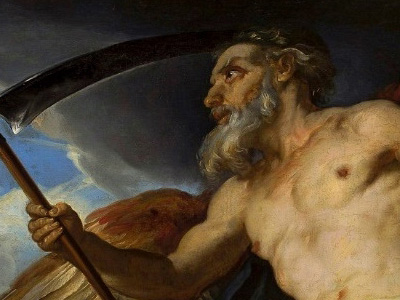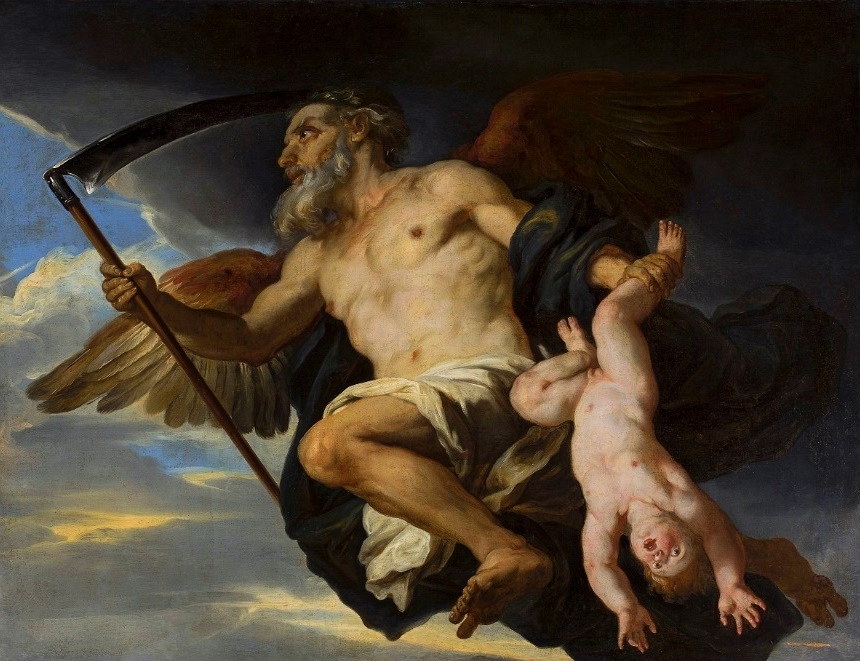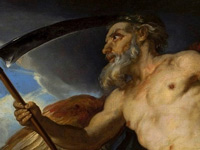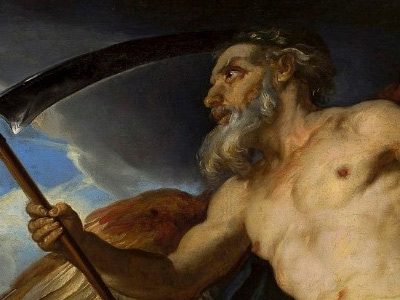Cronus

In Greek mythology, Cronus, Cronos or Kronos (/ˈkroʊnəs/ or /ˈkroʊnɒs/ from Greek: Κρόνος, krónos), was the leader and youngest of the first generation of Titans, the divine descendants of Uranus, the sky, and Gaia, the earth. He overthrew his father and ruled during the mythological Golden Age, until he was overthrown by his own son Zeus and imprisoned in Tartarus. According to Plato, the deities Phorcys, Cronus, and Rhea were the eldest children of Oceanus and Tethys.

Cronus was usually depicted with a harpe, scythe or a sickle, which was the instrument he used to castrate and depose Uranus, his father. In Athens, on the twelfth day of the Attic month of Hekatombaion, a festival called Kronia was held in honour of Cronus to celebrate the harvest, suggesting that, as a result of his association with the virtuous Golden Age, Cronus continued to preside as a patron of harvest. Cronus was also identified in classical antiquity with the Roman deity Saturn. A binary star (HD 240430) discovered in 2017 was named after him.
Mythology
In an ancient myth recorded by Hesiod's Theogony, Cronus envied the power of his father, the ruler of the universe, Uranus. Uranus drew the enmity of Cronus's mother, Gaia, when he hid the gigantic youngest children of Gaia, the hundred-handed Hecatonchires and one-eyed Cyclopes, in Tartarus, so that they would not see the light. Gaia created a great stone sickle and gathered together Cronus and his brothers to persuade them to castrate Uranus.
Only Cronus was willing to do the deed, so Gaia gave him the sickle and placed him in ambush. When Uranus met with Gaia, Cronus attacked him with the sickle, castrating him and casting his testicles into the sea. From the blood that spilled out from Uranus and fell upon the earth, the Gigantes, Erinyes, and Meliae were produced. The testicles produced a white foam from which the goddess Aphrodite emerged. For this, Uranus threatened vengeance and called his sons Titenes (Τιτῆνες; according to Hesiod meaning "straining ones," the source of the word "titan", but this etymology is disputed) for overstepping their boundaries and daring to commit such an act. (In an alternate version of this myth, a more benevolent Cronus overthrew the wicked serpentine Titan Ophion. In doing so, he released the world from bondage and for a time ruled it justly.)
After dispatching Uranus, Cronus re-imprisoned the Hecatonchires, and the Cyclopes and set the dragon Campe to guard them. He and his sister Rhea took the throne of the world as king and queen. The period in which Cronus ruled was called the Golden Age, as the people of the time had no need for laws or rules; everyone did the right thing, and immorality was absent.
Cronus learned from Gaia and Uranus that he was destined to be overcome by his own sons, just as he had overthrown his father. As a result, although he sired the gods Demeter, Hestia, Hera, Hades and Poseidon by Rhea, he devoured them all as soon as they were born to prevent the prophecy. When the sixth child, Zeus, was born Rhea sought Gaia to devise a plan to save them and to eventually get retribution on Cronus for his acts against his father and children. (Cronus also fathered Chiron, by Philyra.)
Rhea secretly gave birth to Zeus in Crete, and handed Cronus a stone wrapped in swaddling clothes, also known as the Omphalos Stone, which he promptly swallowed, thinking that it was his son.
Rhea kept Zeus hidden in a cave on Mount Ida, Crete. According to some versions of the story, he was then raised by a goat named Amalthea, while a company of Kouretes, armored male dancers, shouted and clapped their hands to make enough noise to mask the baby's cries from Cronus. Other versions of the myth have Zeus raised by the nymph Adamanthea, who hid Zeus by dangling him by a rope from a tree so that he was suspended between the earth, the sea, and the sky, all of which were ruled by his father, Cronus. Still other versions of the tale say that Zeus was raised by his grandmother, Gaia.
Once he had grown up, Zeus used an emetic given to him by Gaia to force Cronus to disgorge the contents of his stomach in reverse order: first the stone, which was set down at Pytho under the glens of Mount Parnassus to be a sign to mortal men, and then his two brothers and three sisters. In other versions of the tale, Metis gave Cronus an emetic to force him to disgorge the children, or Zeus cut Cronus's stomach open. After freeing his siblings, Zeus released the Hecatonchires, and the Cyclopes who forged for him his thunderbolts, Poseidon's trident and Hades' helmet of darkness.
In a vast war called the Titanomachy, Zeus and his brothers and sisters, with the help of the Hecatonchires, and Cyclopes, overthrew Cronus and the other Titans. Afterwards, many of the Titans were confined in Tartarus. However, Atlas, Epimetheus, Helios, Menoetius, Oceanus and Prometheus were not imprisoned following the Titanomachy. Gaia bore the monster Typhon to claim revenge for the imprisoned Titans.
Accounts of the fate of Cronus after the Titanomachy differ. In Homeric and other texts he is imprisoned with the other Titans in Tartarus. In Orphic poems, he is imprisoned for eternity in the cave of Nyx. Pindar describes his release from Tartarus, where he is made King of Elysium by Zeus. In another version, the Titans released the Cyclopes from Tartarus, and Cronus was awarded the kingship among them, beginning a Golden Age. In Virgil's Aeneid, it is Latium to which Saturn (Cronus) escapes and ascends as king and lawgiver, following his defeat by his son Jupiter (Zeus).
One other account referred by Robert Graves (who claims to be following the account of the Byzantine mythographer Tzetzes) it is said that Cronus was castrated by his son Zeus just like he had done with his father Uranus before. However the subject of a son castrating his own father, or simply castration in general, was so repudiated by the Greek mythographers of that time that they suppressed it from their accounts until the Christian era (when Tzetzes wrote).
LEGENDS

RESOURCES
This article uses material from the Wikipedia article "Cronus", which is released under the Creative Commons Attribution-Share-Alike License 3.0.
© Stories Preschool. All Rights Reserved.









